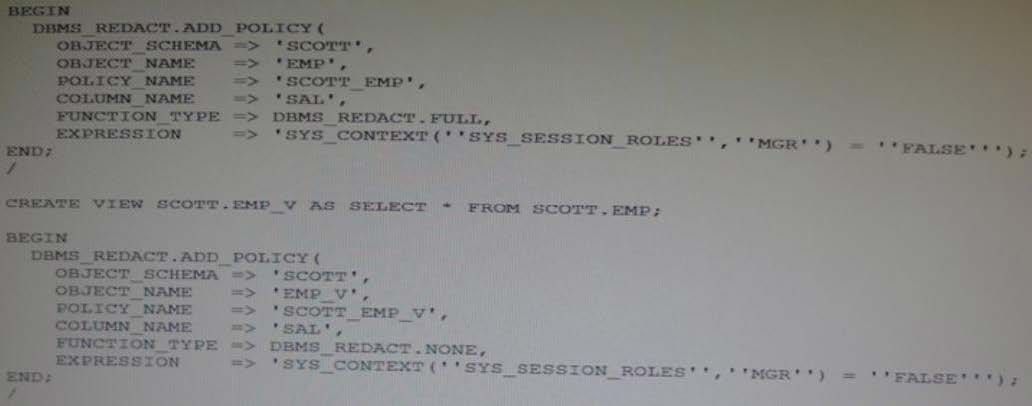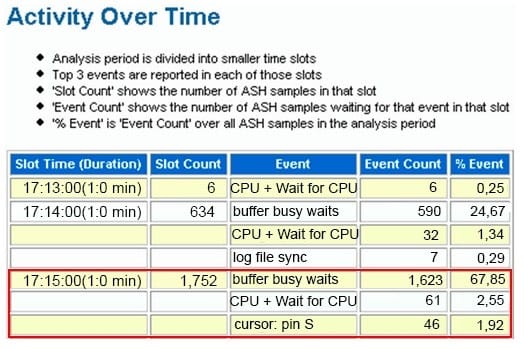1Z0-060 Online Practice Questions and Answers
Examine the following commands for redefining a table with Virtual Private Database (VPD) policies:

Which two statements are true about redefining the table? (Choose two.)
A. All the triggers for the table are disabled without changing any of the column names or column types in the table.
B. The primary key constraint on the EMPLOYEES table is disabled during redefinition.
C. VPD policies are copied from the original table to the new table during online redefinition.
D. You must copy the VPD policies manually from the original table to the new table during online redefinition.
Your multitenant container (CDB) containing three pluggable databases (PDBs) is running in ARCHIVELOG mode. You find that the SYSAUX tablespace is corrupted in the root container.
The steps to recover the tablespace are as follows:
1.
Mount the CDB.
2.
Close all the PDBs.
3.
Open the database.
4.
Apply the archive redo logs.
5.
Restore the data file.
6.
Take the SYSAUX tablespace offline.
7.
Place the SYSAUX tablespace online.
8.
Open all the PDBs with RESETLOGS.
9.
Open the database with RESETLOGS.
10.
Execute the command SHUTDOWN ABORT.
Which option identifies the correct sequence to recover the SYSAUX tablespace?
A. 6, 5, 4, 7
B. 10, 1, 2, 5, 8
C. 10, 1, 2, 5, 4, 9, 8
D. 10, 1, 5, 8, 10
Your multitenant container database (CDB) contains three pluggable database (PDBs). You find that the control file is damaged. You plan to use RMAN to recover the control file. There are no startup triggers associated with the PDBs.
Which three steps should you perform to recover the control file and make the database fully operational? (Choose three.)
A. Mount the container database (CDB) and restore the control file from the control file autobackup.
B. Recover and open the CDB in NORMAL mode.
C. Mount the CDB and then recover and open the database, with the RESETLOGS option.
D. Open all the pluggable databases.
E. Recover each pluggable database.
F. Start the database instance in the nomount stage and restore the control file from control file autobackup.
In a recent Automatic Workload Repository (AWR) report for your database, you notice a high number of buffer busy waits. The database consists of locally managed tablespaces with free list managed segments.
On further investigation, you find that buffer busy waits is caused by contention on data blocks.
Which option would you consider first to decrease the wait event immediately?
A. Decreasing PCTUSED
B. Decreasing PCTFREE
C. Increasing the number of DBWN process
D. Using Automatic Segment Space Management (ASSM)
E. Increasing db_buffer_cache based on the V$DB_CACHE_ADVICE recommendation
You notice that the elapsed time for an important database scheduler Job is unacceptably long.
The job belongs to a scheduler job class and runs in a scheduler window.
Which two actions could reduce the job's elapsed time?
A. increasing the priority of the job class to which the job belongs
B. increasing the job's relative priority within the job class to which it belongs
C. increasing resource allocation for the consumer group mapped to the job class in the resource manager plan associated with the scheduler window
D. moving the job to an existing higher priority scheduler window with the same schedule and duration
E. increasing the value of the JOB_QUEUE_PROCESSES parameter
F. increasing the priority of the scheduler window to which the job belongs
You execute the following piece of code with appropriate privileges: User SCOTT has been granted the CREATE SESSION privilege and the MGR role.

Which two statements are true when a session logged in as SCOTT queries the SAL column in the view and the table?
A. Data is redacted for the EMP.SAL column only if the SCOTT session does not have the MGR role set.
B. Data is redacted for EMP.SAL column only if the SCOTT session has the MGR role set.
C. Data is never redacted for the EMP_V.SAL column.
D. Data is redacted for the EMP_V.SAL column only if the SCOTT session has the MGR role set.
E. Data is redacted for the EMP_V.SAL column only if the SCOTT session does not have the MGR role set.
You execute the following commands to audit database activities:

Which statement is true about the audit record that generated when auditing after instance restarts?
A. One audit record is created for every successful execution of a SELECT, INSERT or DELETE command on a table, and contains the SQL text for the SQL Statements.
B. One audit record is created for every successful execution of a SELECT, INSERT or DELETE command, and contains the execution plan for the SQL statements.
C. One audit record is created for the whole session if JOHN successfully executes a SELECT, INSERT, or DELETE command, and contains the execution plan for the SQL statements.
D. One audit record is created for the whole session if JOHN successfully executes a select command, and contains the SQL text and bind variables used.
E. One audit record is created for the whole session if john successfully executes a SELECT, INSERT, or DELETE command on a table, and contains the execution plan, SQL text, and bind variables used.
Identify three scenarios in which you would recommend the use of SQL Performance Analyzer to analyze impact on the performance of SQL statements.
A. Change in the Oracle Database version
B. Change in your network infrastructure
C. Change in the hardware configuration of the database server
D. Migration of database storage from non-ASM to ASM storage
E. Database and operating system upgrade
Examine the parameters for your database instance:

Which three statements are true about the process of automatic optimization by using cardinality feedback?
A. The optimizer automatically changes a plan during subsequent execution of a SQL statement if there is a huge difference in optimizer estimates and execution statistics.
B. The optimizer can re optimize a query only once using cardinality feedback.
C. The optimizer enables monitoring for cardinality feedback after the first execution of a query.
D. The optimizer does not monitor cardinality feedback if dynamic sampling and multicolumn statistics are enabled.
E. After the optimizer identifies a query as a re-optimization candidate, statistics collected by the collectors are submitted to the optimizer.
Examine the details of the Top 5 Timed Events in the following Automatic Workloads Repository (AWR) report:

What are three possible causes for the latch-related wait events?
A. The size of the shared pool is too small.
B. Cursors are not being shared.
C. A large number COMMITS are being performed.
D. There are frequent logons and logoffs.
E. The buffers are being read into the buffer cache, but some other session is changing the buffers.
Which three activities are supported by the Data Recovery Advisor? (Choose three.)
A. Advising on block checksum failures
B. Advising on inaccessible control files
C. Advising on inaccessible block change tracking files
D. Advising on empty password files
E. Advising on invalid block header field values
Which three statements are true about the working of system privileges in a multitenant control database (CDB) that has pluggable databases (PDBs)?
A. System privileges apply only to the PDB in which they are used.
B. Local users cannot use local system privileges on the schema of a common user.
C. The granter of system privileges must possess the set container privilege.
D. Common users connected to a PDB can exercise privileges across other PDBs.
E. System privileges with the with grant option container all clause must be granted to a common user before the common user can grant privileges to other users.
Your database has the SRV1 service configured for an application that runs on middle-tier application server. The application has multiple modules. You enable tracing at the service level by executing the following command:

The possible outcomes of this command and the actions to aggregate trace files are as follows:
1.
The command fails because a module name is not specified.
2.
A trace file is created for each session that is running the SRV1 service.
3.
An aggregated trace file is created for all the sessions that are running the SRV1 service.
4.
Trace files may be aggregated by using the trcess utility.
5.
Trace files may be aggregated by using the tkprof utility.
Identify the correct outcome and the action to aggregate the trace files.
A. 1
B. 2 and 4
C. 2 and 5
D. 3 and 4
E. 3 and 5
While investigating a possible security breach, you realized that some audit records were not retrieved when the UNIFIED_AUDIT_TRAIL view was queried.
How can you ensure that all available audit records are returned when the audit trail is queried?
A. Query the v$UNIFIED_AUDIT_TRAIL view rather than the UNIFIED_AUDIT_TRAIL view.
B. Enable the OS auditing option in the database before querying the UNIFIED_AUDIT_TRAIL view.
C. Configure the IMMEDIATE write mode using the DBMS_AUDIT_MGMT.SET_AUDIT_TRAIL view.
D. Execute the DBMS_AUDIT_MGMT.FLUSH_INIFIED_AUDIT_TRAIL procedure before querying the UNIFIED_AUDIT_TRAIL view.
Examine the portion of this Active Session History (ASH) report that is marked with a red rectangle:

Which two inferences can be drawn from the report?
A. Sessions attempting to modify blocks images in the buffer cache are waiting while other sessions are reading the same block images.
B. Sessions are waiting to find free buffers in the buffer cache.
C. Sessions are waiting for writes of modified block images in the buffer cache to complete
D. Sessions are attempting to read blocks images in the buffer cache are waiting while other sessions are reading the same block images.
E. Sessions attempting to read blocks images in the buffer cache are waiting while other sessions are modifying the same block images.
